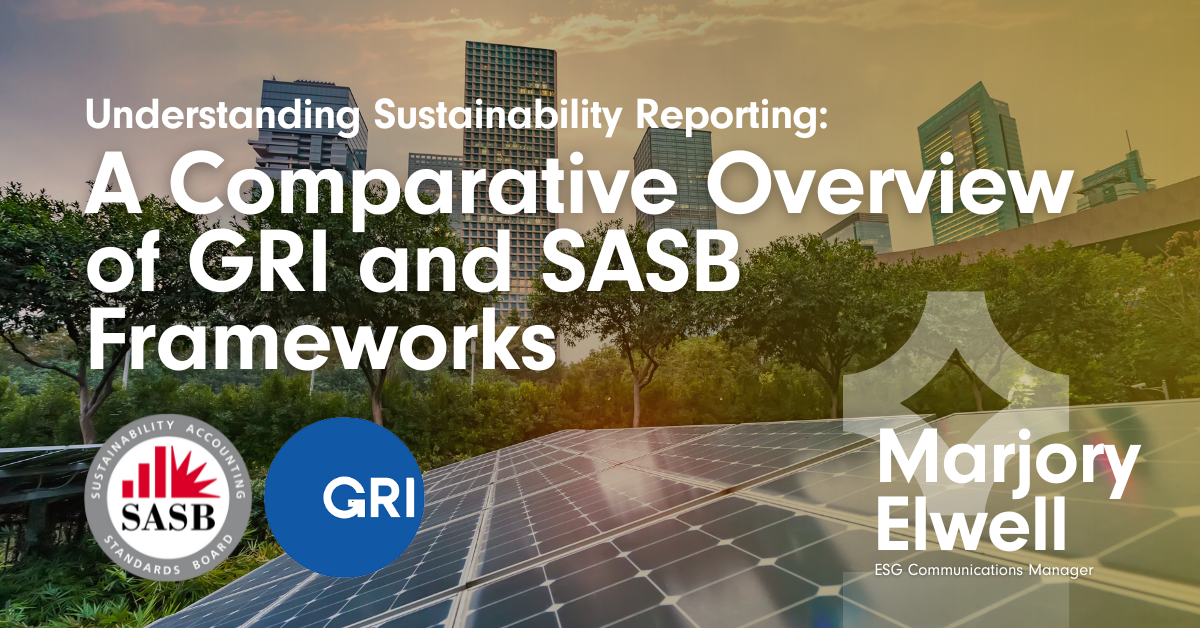Understanding Sustainability Reporting: A Comparative Overview of GRI and SASB Frameworks
If your company is gearing up to release an environmental, social, and governance (ESG) report, you'll probably find yourself faced with the decision of choosing a reporting framework. Likely at the top of the list: the Global Reporting Initiative (GRI) and Sustainable Accounting Standards Board (SASB).
Both GRI and SASB play pivotal roles in helping companies communicate ESG impacts. In this post, we'll explore the key differences between the two and provide guidance on how companies can determine which framework is best for them.
GRI: A Comprehensive Approach to Sustainability Reporting
GRI can be used by any business or organization, regardless of size, ownership, industry, location, or reporting history, including large multinational corporations, small and medium sized businesses, nonprofit organizations, government entities, and international organizations. Utilized by over 10,000 companies in over 100 countries, GRI is a widely accepted and leading international standard.
The framework enables organizations to credibly disclose their most significant impacts on the economy, environment, and people, as well as how those impacts are managed. GRI does not look at the effect these topics have on the organization itself and its operations.
For companies looking to report on their ESG strategy, this modular system comprising three series – GRI Universal Standards, the GRI Sector Standards, and the GRI Topic Standards – has a lot to offer. In addition to a flexible structure, GRI is compatible with other reporting frameworks, aligned with best practices for impact reporting, and updated to reflect the latest developments. The framework’s eight reporting principles – accuracy, balance, clarity, compatibility, completeness, sustainability context, transparency, and verifiability – are an especially helpful requirement in creating a credible report.
SASB: Industry-Specific and Financially Material
Sustainability has become a key element in investment decision making. Increasingly, companies are being called on to provide details on sustainability-related risks and opportunities. Now part of the International Sustainability Standards Board (ISSB), SASB establishes and maintains industry-specific standards for guiding companies’ disclosures of financially material sustainability information to investors and other stakeholders. The framework is, first and foremost, a financial tool.
The Standards are meticulously tailored to 77 different industries, recognizing the variety of sustainability issues across sectors. This industry-specific approach ensures that companies report on issues most critical to their industry's financial health.
SASB Standards were developed based on extensive feedback from companies, investors, and other market participants as part of a transparent, publicly documented process. This detailed undertaking includes evidence-based research, broad participation from companies, investors, and subject matter experts, as well oversight and approval from an independent Standards Board.
The Dual Approach
Since GRI and SASB are compatible for sustainability reporting, many companies utilize both. In general, SASB and GRI are designed to fulfill different purposes and are based on different approaches to materiality, but this dual approach can offer the best of both worlds – providing a comprehensive overview of sustainability impacts while satisfying the financial focus of investors.
As companies are increasingly expected to disclose their sustainability performance, reporting based on both GRI and SASB Standards, while not required, can provide the depth of disclosure that an organization’s stakeholders are looking for in a report.
What’s Next?
Selecting the ideal sustainability reporting framework(s) is a critical step in communicating your ESG narrative accurately and effectively. Whether you opt for GRI's comprehensive approach or SASB's financial materiality focus, the key is to ensure transparency, credibility, and alignment with your organization's unique commitments.
If you need help determining the best framework for your company, aligning your reporting, or telling your ESG story, Uplift is here to help.
The Uplift Agency
Uplift builds strategies, programs, and communication campaigns that advance ESG in workplaces, supply chains and communities.
We know how to navigate the road ahead because we’ve already been down it – 90 percent of our team has led environmental or social programs in corporations or nonprofits. Because ESG is all we do, our services are more comprehensive and integrated than most firms.


